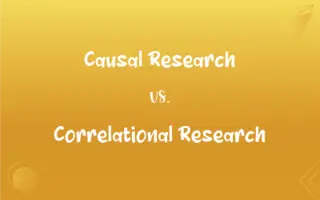Systolic Blood Pressure vs. Diastolic Blood Pressure: What's the Difference?
Edited by Aimie Carlson || By Harlon Moss || Updated on October 9, 2023
Systolic blood pressure measures pressure when the heart beats; diastolic measures pressure when the heart rests between beats.

Key Differences
Systolic blood pressure refers to the highest pressure level in the arteries, occurring when the heart contracts to pump blood out. It represents the force exerted on the arterial walls during a heartbeat. On the other hand, diastolic blood pressure signifies the lowest pressure level in the arteries when the heart is at rest between beats. It showcases the resistance of the arteries when the heart is not actively pumping.
A blood pressure reading typically provides two numbers. The systolic blood pressure is the first or top number, while the diastolic blood pressure is the second or bottom number. For instance, in a reading of 120/80 mm Hg, 120 represents the systolic pressure, and 80 represents the diastolic pressure.
High systolic blood pressure can indicate risks like heart disease or stroke due to the increased force on arterial walls. Elevated diastolic blood pressure might suggest the arteries are too narrow or stiff, preventing them from expanding and contracting easily.
Both systolic and diastolic pressures are vital for assessing one's overall cardiovascular health. While it's common for attention to gravitate toward systolic pressure as a primary risk factor for cardiovascular diseases, especially in older adults, diastolic pressure is equally crucial, especially in younger individuals.
Comparison Chart
When Measured
During heart's contraction
During heart's rest
ADVERTISEMENT
Representation in BP Reading
Top number
Bottom number
Indicates
Force on arterial walls during heartbeat
Resistance of arteries during heart rest
Associated Risks
Heart disease, stroke
Arterial stiffness, narrowness
Typically Higher in
Older adults
Younger individuals
Systolic Blood Pressure and Diastolic Blood Pressure Definitions
Systolic Blood Pressure
The pressure in arteries when the heart beats.
Her systolic blood pressure was slightly elevated during the exam.
ADVERTISEMENT
Diastolic Blood Pressure
The bottom number in a blood pressure reading.
A diastolic blood pressure of 90 mm Hg suggests borderline hypertension.
Systolic Blood Pressure
The top number in a blood pressure reading.
A systolic blood pressure of 130 mm Hg is considered high.
Diastolic Blood Pressure
Measurement of minimum arterial pressure during one cardiac cycle.
Persistent high diastolic blood pressure can stress the heart and damage arteries.
Systolic Blood Pressure
Represents the force exerted on arterial walls during a heartbeat.
The doctor noted his systolic blood pressure was within a normal range.
Diastolic Blood Pressure
Indicates arterial elasticity between heartbeats.
Proper exercise helps maintain healthy diastolic blood pressure.
Systolic Blood Pressure
The maximum arterial pressure during one cardiac cycle.
Her systolic blood pressure consistently read above 140 mm Hg, indicating hypertension.
Diastolic Blood Pressure
The pressure in arteries when the heart is at rest.
His diastolic blood pressure was a perfect 80 mm Hg.
Systolic Blood Pressure
Measurement of arterial pressure during heart contraction.
Maintaining a healthy systolic blood pressure is crucial for cardiovascular health.
Diastolic Blood Pressure
Represents the arterial resistance when the heart isn't beating.
Diastolic blood pressure readings below 60 mm Hg may indicate a problem.
FAQs
What does systolic blood pressure represent?
Systolic blood pressure represents the pressure when the heart beats.
When is diastolic blood pressure measured?
Diastolic blood pressure is measured when the heart is at rest between beats.
Which pressure, systolic or diastolic, indicates arterial stiffness?
Elevated diastolic blood pressure can indicate arterial stiffness.
Which blood pressure reading, systolic or diastolic, showcases the force on arterial walls?
The systolic blood pressure showcases the force on arterial walls.
Can high systolic blood pressure indicate cardiovascular risks?
Yes, high systolic pressure can suggest risks like heart disease or stroke.
What's a normal range for diastolic blood pressure?
A normal range for diastolic blood pressure is typically 60-80 mm Hg.
Is the systolic or diastolic number on top in a BP reading?
The systolic number is the top number in a blood pressure reading.
Are there different treatments for high systolic vs. high diastolic blood pressure?
Treatment approaches may vary, but both forms of high blood pressure can often be managed with similar strategies.
Can exercise affect my systolic and diastolic blood pressures?
Yes, regular exercise can help lower both systolic and diastolic pressures.
Is a low diastolic blood pressure cause for concern?
Yes, very low diastolic pressure can reduce blood flow to the heart and brain.
Can systolic and diastolic blood pressures be too low?
Yes, both systolic and diastolic pressures that are too low can indicate health issues.
How do systolic and diastolic pressures relate to the cardiac cycle?
Systolic pressure occurs during the heart's contraction, while diastolic occurs during its rest.
Why is monitoring systolic blood pressure important in older adults?
In older adults, high systolic blood pressure is a major risk factor for cardiovascular diseases.
Which blood pressure number is more crucial in younger individuals?
Diastolic pressure is often considered more significant in younger individuals.
How can I lower my systolic blood pressure?
Lifestyle changes, like a healthy diet, exercise, and medication, can help lower systolic blood pressure.
Which is more commonly elevated in the elderly, systolic or diastolic blood pressure?
Systolic blood pressure is more commonly elevated in the elderly.
Which blood pressure, systolic or diastolic, is linked to arterial narrowness?
Elevated diastolic blood pressure might suggest narrow or stiff arteries.
Can I have high systolic blood pressure but normal diastolic blood pressure?
Yes, it's possible to have isolated systolic hypertension, where only the systolic pressure is elevated.
What does it mean if both my systolic and diastolic numbers are high?
Both high systolic and diastolic readings indicate hypertension or high blood pressure.
When is the diastolic pressure at its lowest?
Diastolic pressure is at its lowest when the heart is resting between beats.
About Author
Written by
Harlon MossHarlon is a seasoned quality moderator and accomplished content writer for Difference Wiki. An alumnus of the prestigious University of California, he earned his degree in Computer Science. Leveraging his academic background, Harlon brings a meticulous and informed perspective to his work, ensuring content accuracy and excellence.
Edited by
Aimie CarlsonAimie Carlson, holding a master's degree in English literature, is a fervent English language enthusiast. She lends her writing talents to Difference Wiki, a prominent website that specializes in comparisons, offering readers insightful analyses that both captivate and inform.



































































